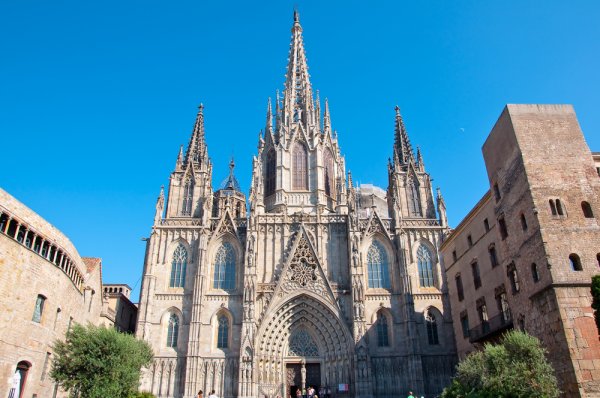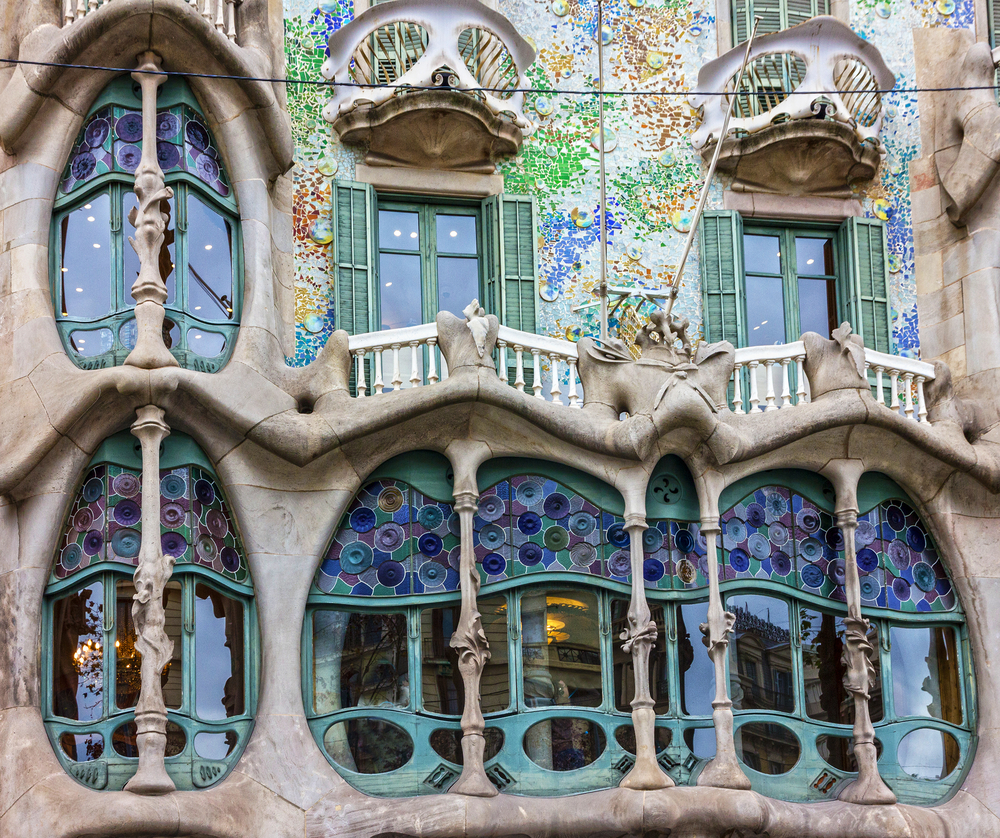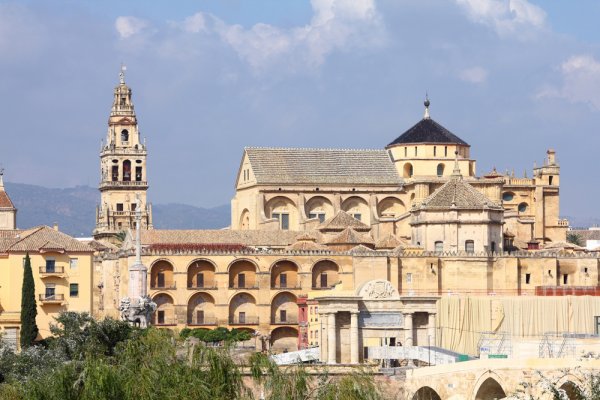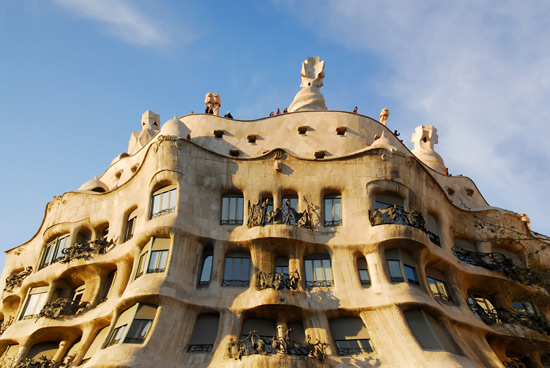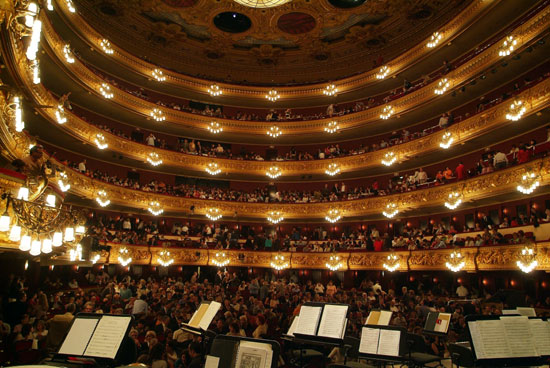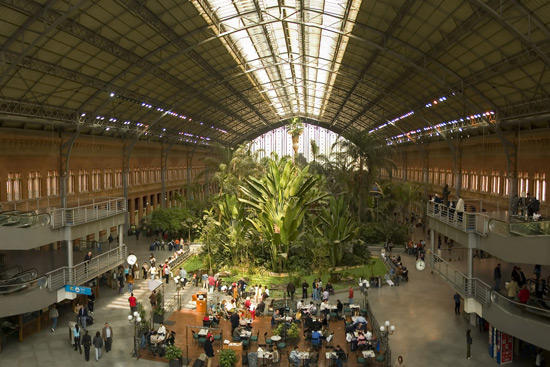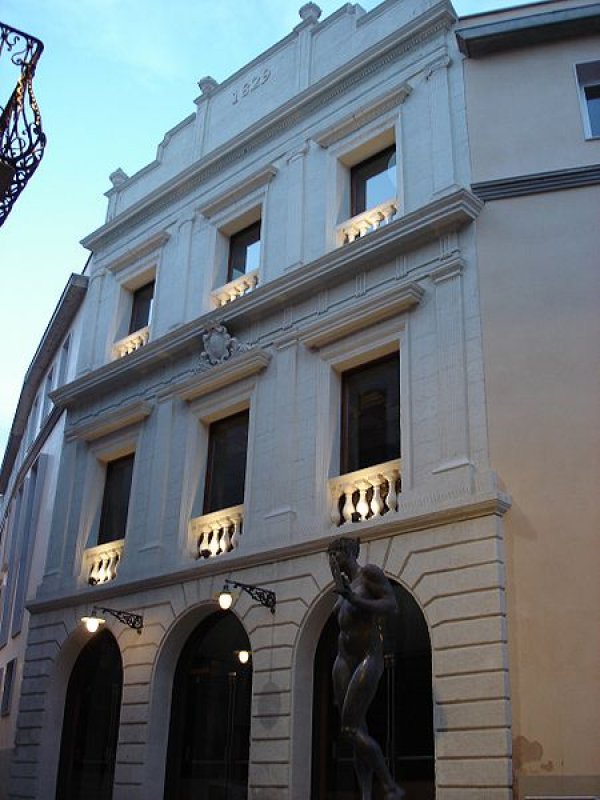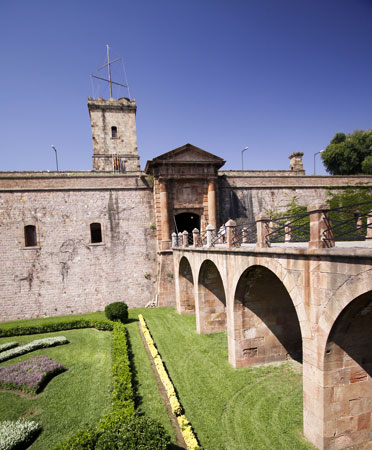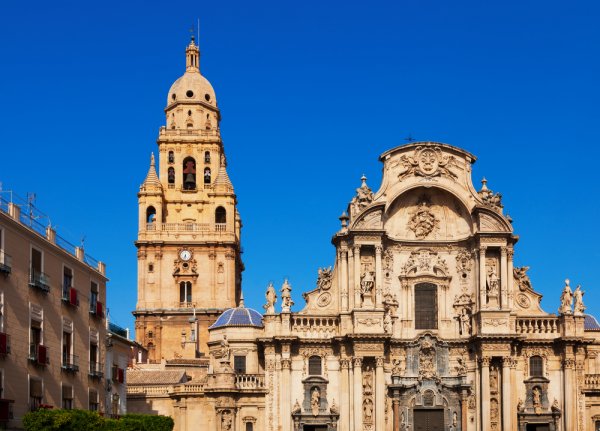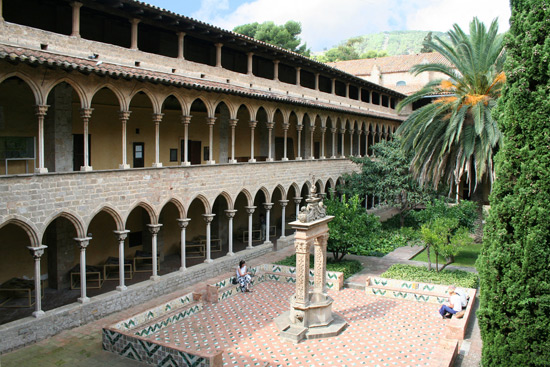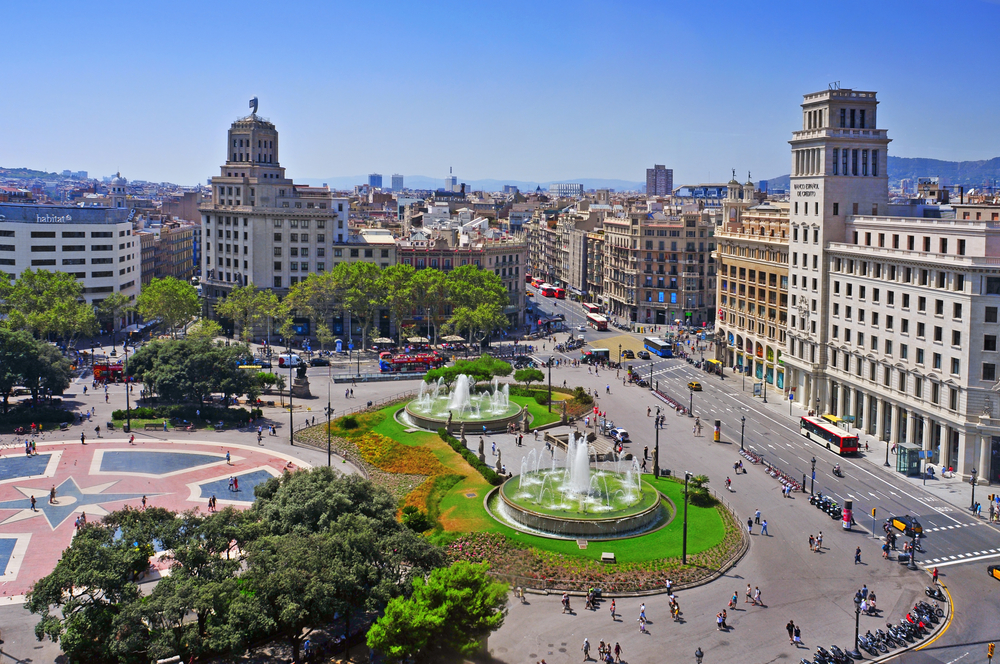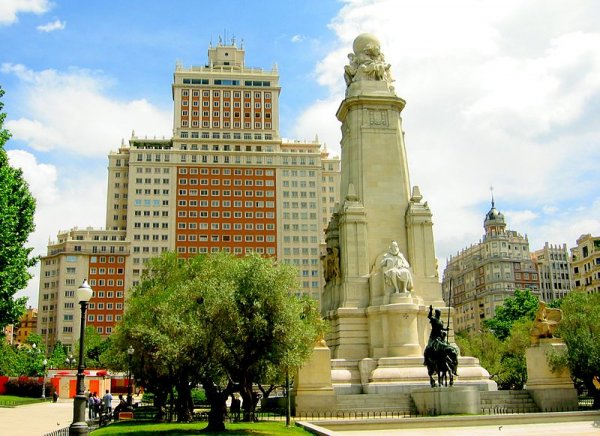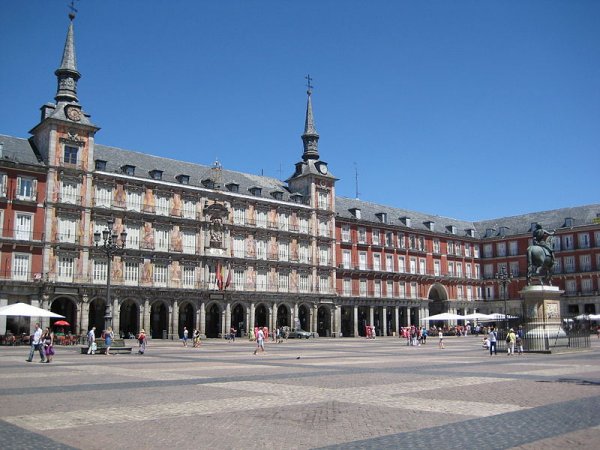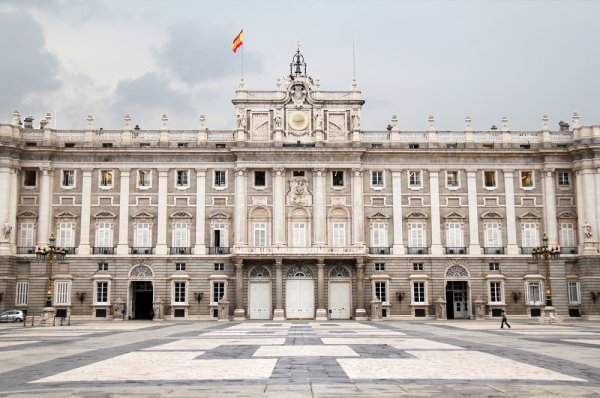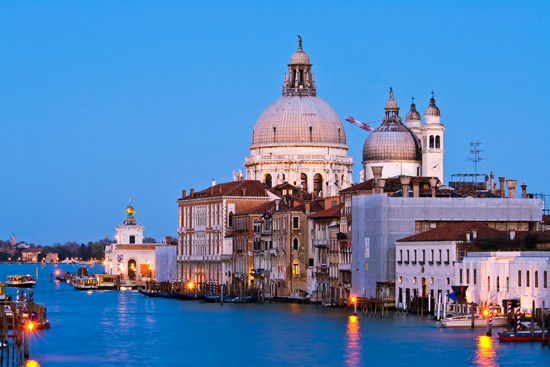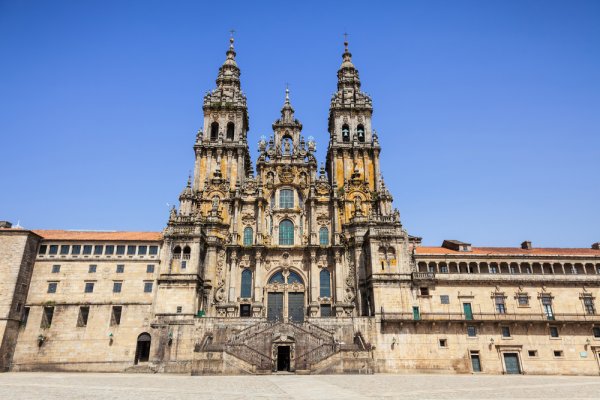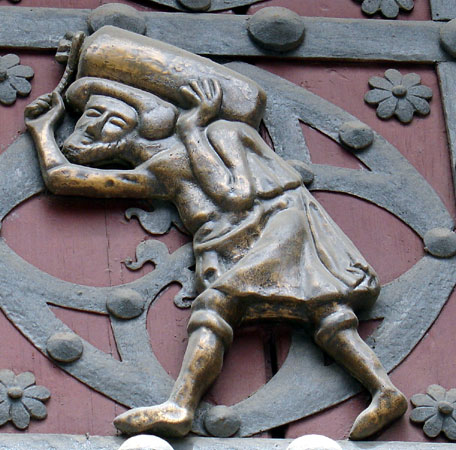Points of Interest
Agbar Tower
Torre Agbar 211 Avinguda Diagonal
Barcelona 08018, Spain
When the rounded Agbar Tower opened in 2005, it instantly became one of the city's most distinctive buildings. French architect Jean Nouvel has described it as a geyser rising up out of the ground. That would please the current owners of the building, the Catalan water board Aigües de Barcelona. Other critics have been less generous, labeling it "El Supositori." Whether they like or loathe the cucumber-shaped skyscraper, visitors can't fail to be impressed by its aspect at night, when the red and blue glass panels that cloak its façade sparkle and shimmer. Inside, it makes a greener impact, with window sensors that regulate the blinds, reducing energy consumption. The particular types of aluminum and glass can also alter the building's coloring depending on the seasons. Although the interior of the building is off limits to tourists, there are often exhibitions in the foyer.
Arab Wall
Muralla árabe Cuesta de la Vega
Madrid, Spain
You'll find no palaces here, no museums, nor modern art galleries. But this is where Madrid started out, as an Arab fortress built on the site near a supply of fresh water. Mayrit, deriving from the Arabic words for water source, eventually became Madrid. As a survival necessity, water played a vital role in medieval castle planning. After all, even the most impregnable mountaintop stronghold will prove to be of little avail without adequate drinkable water. At Cuesta de la Vega, visitors can see the city's last remaining stones from the old Arab wall. The wall is part of the fort built on the banks of Rio Manzanares in the ninth century by Mohammed I, Emir of Cordoba.
Barcelona Cathedral
Catedral de Barcelona s/n Pla de la Seu Gothic District
Barcelona, Catalonia 08002, Spain
Popularly known as the La Seu, this cathedral is dedicated to Saint Eulalia, co-patron saint of Barcelona, and is the seat of the Roman Catholic Archbishop of Barcelona. This Gothic cathedral was built in 1298 on top of a former Visigoth church. The Gothic façade and the spire were added in the 19th century based on the design of French architect Charles Galters. The octagonal clock towers have a height of 50 meters (164 feet). The interior includes a wide nave, 28 side chapels, a carved choir, and a crypt containing the sarcophagus of Santa Eulalia. A 14th-century cloister with a central courtyard and a small museum adjoins the cathedral.
CaixaForum Madrid
Paseo del Prado 36
Madrid, Spain
This iconoclastic gallery stands among the venerable buildings of Paseo del Prado. Built on the site of an old power station, the structure was adapted by Swiss architects Herzog and de Meuron (who performed similar sleight of hand with London's Tate Modern). Opening in 2008, CaixaForum was an instant hit with Madrileños thirsty for contemporary architecture. The Swiss team kept the brick shell of the power station, but removed the heavy stone base which seemed to anchor it to the ground. Instead, they built additional levels clad in rusted steel. Completed, the ensemble looks something like a cross between a Moorish fortress and an abstract painting by Mark Rothko. On the wall beside the gallery, Herzog and de Meuron designed a four-story hanging garden, an expanse of green in counterpoint to the monolithic red of the metal. Catalan building society La Caixa sponsors the exhibitions inside, but the building alone is worth seeing.
Casa Batlló
Passeig de Gràcia, 43
Barcelona, Spain
Casa Batlló is one of the two great buildings designed by Catalan architect, Antoni Gaudí. A pioneering figure of Art Nouveau and modernism, Gaudí has several famous buildings in Barcelona, many featuring wavy shapes, patterns, bright colors, and designs that seem from a fantasy world. Casa Batlló is a UNESCO World Heritage site and one of Barcelona’s most iconic avenues thanks to its modernist legacy. From the outside the façade looks like it has been made from skulls and bones. The skulls are in fact balconies and the bones are supporting pillars. Gaudí used colors and shapes found in marine life as inspiration for the building. An audio tour gives fascinating insights into Gaudí and his influences when designing the house. A theatrical tour takes place only on Sundays, and admission for children under age 7 is free.
—Information provided by Barcelona Tourist Guide and Casa Batlló
Great Mosque
Cathedral of Cordoba 1 Calle del Cardenal Herrero
Córdoba 14003, Spain
This masterpiece of Moorish architecture brings throngs of visitors each year. Cordoba served as Spain's center of Islamic power, and its mosque, once the second largest in the world, displays exquisite artistry. Towering stone walls with massive, bronze doors that close each night encircle the structure and its garden. The mosque's interior features more than 850 granite, jasper and marble columns; ornate ceiling freize patterns; and elaborate altars of the later Christian influence. A cathedral was built inside the mosque in the 16th century and takes up less than half of the interior, as King Ferdinand III didn't wish to destroy the artistry of the Moors. The exterior of the mosque-cathedral boasts a classic, Moorish garden complete with a grove of orange trees. Outside the mosque walls, one will find the old, Moorish section of Cordoba, another treasure well worth exploring.
Hermitage of Saint Anthony of La Florida
Ermita de San Antonio de la Florida Glorieta de San Antonio de la Florida 4
Madrid 28008, Spain
If you're a lover of Goya, head to this church on the banks of the Manzanares, where he not only executed one of his most splendid works, but where he is also buried. The neoclassical church was constructed between 1792 and 1798; Goya painted his exceptional fresco over several months in the final year of building. Depicting the miracles of St. Anthony of Padua, Goya used some artistic license in relocating one of the incidents from Lisbon to Madrid. Look for the artist appearing in his own work: He's the man almost covered by his black cloak. Young single women attend this church on June 13 every year to pray for a partner. Although Goya died in Bordeaux, France, his body was reinterred here in 1919. Interestingly, the artist's head was stolen in France, so only his body is buried here.
La Alhambra
s/n Calle Real de la Alhambra
Granada 18009, Spain
One of the most popular tourist destination in Spain, La Alhambra (Red One) is an Arabian palace whose name refers to the color of the mountain on which it stands. A pristine example of Moorish architecture, the palace has two entrances, the Puerta de las Armas in the north and the Puerta de la Justicia in the south. Originally a military citadel, the palace is surrounded by a strong fortified wall flanked by 13 towers. Some of the attractions include well-preserved museums, the Golden Room with its Renaissance ceiling, Hall of the Mozarabes, Hall of the Abencerrajes, Sala de las Dos Hermanas, and the King's Hall. While some of the walls are engraved with Arabic poems or Koranic extracts, others are decorated with Arabian art. The exterior gardens and tower turrets with splendid views of surrounding Granada make this a gem worth visiting. Visitors to the Alhambra should also take in the adjoining Generalife palace and the Albyczin area of Granada.
La Pedrera
261-265 Provença
Barcelona 08008, Spain
Once a city joke, this Gaudí-designed building is now a Barcelona institution. It was constructed from 1906 to 1912, commissioned by Pere Milà, a flashy developer who had married a rich widow. Both Milà's taste and Gaudí's sinuous architecture were ridiculed at the time, leading to the nickname La Pedrera (The Stone Quarry). One local painter, commenting on the building's lack of straight lines, remarked that the owner shouldn't own a pet dog, but a snake. La Pedrera's organic, quasi-cellular façade is only the most visible attribute of the building. Guadí's genius spanned both engineering (structurally, the building's weight rests on pillars, rather than load-bearing walls, making development easier) and design (the catenary arches, ceilings with sea spume decor, or ventilation ducts on the roof shaped like knights' helmets). This is truly an extraordinary building.
La Sagrada Familia
401 Carrer de Mallorca
Barcelona 08013, Spain
Usually referred to simply as La Sagrada Familia (The Holy Family), this large Roman Catholic basilica is expected to be completed in 2026. The original designer, Antoni Gaudí, infused the design with Christian symbolism and intended the cathedral to be the greatest icon of Christendom. After Gaudí's death, other eminent architects resumed work on the cathedral. One of the striking features of the cathedral is the 18 spindle-shaped towers representing the 12 apostles, four evangelists, the Virgin, and Christ. The eastern façade, called the Nativity Façade, reflects a Baroque style, and is situated opposite to the Passion Façade, which includes abstract depictions of the crucifixion. The southern face, or Glory Façade, depicts the life and death of humankind.
Liceu Grand Theater
Gran Teatre del Liceu 51-59 Les Rambles
Barcelona 08002, Spain
Opened in 1847, the Liceu is Spain's main opera house and, besides remaining a fine symbol of the city's art and culture, also holds the distinction of having one of the world's largest opera stages. The building was damaged during a period of social unrest in the late 19th century, but the theater reopened after a year. The opera house prospered in the early 20th century, although the Spanish Civil War caused the suspension of opera performances for a few years. The building was again destroyed by fire in 1994 and rebuilt around the undamaged parts. The new and improved structure, equipped with state-of-the-art acoustics and stage technology, opened its doors in 1999.
Madrid Atocha Station
Glorieta del Emperador Carlos V
Madrid, Spain
Madrid's first railroad station is also its most celebrated. Built in 1851, it burned down at the end of the century and was redesigned in wrought iron by Alberto de Palacio Elissagne, a student of Gustave Eiffel. In the 1980s, Spanish architect Rafael Moneo supervised a project to shift the station's commuter traffic to a purpose-built terminal. The iron-and-glass concourse became a destination for pedestrians, with a tropical garden covering 4,000 square meters (43,055 square feet). The new station was completed in 1992, with renovation timed for Spain's hosting of the Olympic Games. Look out for the memorial dedicated to the victims of the March 2004 Madrid bombings. There's a high-tech shrine where visitors can leave a hand silhouette, and a more organic monument comprising 192 olive and cypress trees, commemorating the 192 innocents who died in the tragedy.
Maó Theater
Teatre Principal de Maó Carrer d'en Deià, 40 Maó-Mahón
Menorca 07702, Spain
Known more popularly in local circles as The Principal, the Teatre Principal de Maó is one of the oldest opera settings in Spain. It was built in 1829 along the lines of 18th-century Italian opera houses. The Principal is the venue for the annual Opera Week, an event where masters of Bel Canto, a style that originated in Italy in the 16th century, perform.
Montjuïc Castle
Castell de Montjuïc 66 Carretera de Montjuïc
Barcelona 08038, Spain
For many years, this attractive hillside was far from ever being one of the city's tourist hotspots. Many who were transported to the dark-stoned fortress on the summit were never seen again. The castle was built in the mid-17th century and used by both Philip V of Spain and General Francisco Franco to subdue Barcelona. Among its victims was Lluís Companys, a Catalan leader extradited by the Nazis in 1940 and executed by another of El Generalísimo's firing squads. In 2007, however, control of the once hated castle passed to Barcelona's city council and a year later, thousands of locals streamed up the hill named after the Jewish cemetery to celebrate. Visitors today can enjoy a view once seen only by Franco's gunners, overlooking the whole of the city.
Murcia Cathedral
Catedral de Murcia 1 Plaza del Cardenal Belluga
Region of Murcia 30001, Spain
Murica Cathedral was constructed on the site of the former Great Mosque or Aljamía. The cathedral was completed in 1467 but continued to grow until the 18th-century, incorporating various artistic styles. The cathedral's façade is from the Baroque period, with a bell tower that measures 90 meters (295 feet) in height and has distinctively styled stages. Some important chapels include the Vélez Chapel in a Flaming Gothic style, the baroque-style Chapel of the Immaculate, and the Chapel of the Junterones of the Spanish Renaissance. The remains of King Alfonso X the Wise are interred under the main altar.
Palace of Catalan Music
C/ Palau de la Música, 4–6
Barcelona 08003, Spain
This concert hall was built in 1908 for the Orfeó Català, a choral society. Featuring a Catalan Modernisme design, the distinctive features of the brick-and-iron structure include curves, dynamic shapes, and a rich decoration of floral and other organic motifs. This structure is the only one of its kind in Europe that is illuminated entirely by natural light during the day. The concert hall, with a seating capacity of 2,200, has walls of stained glass and an inverted dome in gold and blue that gives an illusion of the sun and the sky. The Lluís Millet hall on the second floor is a gathering place for concert-goers and also used as a teaching area for tourists.
Pedralbes Monastery
Monestir de Pedralbes 9 Baixada del Monestir
Barcelona 08034, Spain
Named after its white stones (pertas albes in Catalan), this serene monastery was founded in 1326 by Elisenda de Montcada, the queen of Jaume II. Once the convent of the Order of St. Clare, it is now Barcelona's best example of Gothic cloisters, a three-story quadrilateral at the base of which are an herb garden, fountain, and well. There is also a church that contains Giotto-esque murals by Catalan artist Ferrer Bassa. In the residence where the nuns used to live, visitors can see original artifacts, tour the refectory, and recreate the ordinary lives of the St. Clare sisters. Look on the floor of the arcaded walkways of the church for the wheel marks carved by Napoleon's cannons, evidence of the French occupation of 1809.
Plaza Catalonia
Plaça de Catalunya Barcelona 08002, Spain
Plaça Catalunya is a prominent square in central Barcelona that was developed in 1888. Regarded as the meeting place of the old city and the 19th-century extension (Eixample District), the 5-hectare (12 acres) square is a vantage point for some of the most popular attractions in the city. Other attractions of the square include fountains, statues, and pigeon haunts. The area around Font de Canaletes is frequently used for demonstrations. The square is also the nerve center of Barcelona's transport system.
Plaza de España
Plaza de España
Madrid 28008, Spain
Plaza de España stands on a site that was occupied by a barrack near the Palacio Real. It features a monument to Miguel de Cervantes Saavedra, the famous Spanish poet, playwright, and creator of the fictional Don Quixote de la Mancha. The tower also houses bronze sculptures of Don Quixote and his squire, Sancho Panza. Two of Madrid's most prominent skyscrapers, Torre de Madrid and Edificio España, flank the plaza.
Plaza Mayor
Madrid 28012, Spain
This grand arcaded central piazza in Madrid, built during the Austrian period, covers an area of 1.14 hectares (2.8 acres). The Plaza was designed by Juan de Villanueva at the behest of Philip III and completed in 1790. Juan de Bolonia's statue of Philip III on horseback occupies the center of the square. Celebrations for San Isidro (patron saint of Madrid) are held in the plaza. There are nine entranceways and a multitude of traditional shops and cafes beneath the porticos of the plaza. The Casa de la Panadería (Home of the Bakers Guild) dominates the plaza and includes impressive Flemish-style twin towers and spires.
Royal Palace of Madrid
Palacio Real de Madrid s/n Calle Bailén
Madrid 28071, Spain
Although the Royal Palace of Madrid is the official residence of Spain's King, the royal family does not reside here. Owned by the Spanish state, the Palacio is one of Europe's finest and largest palaces and is used primarily for state ceremonies. Commissioned by King Philip V and designed by Juan Bautista Sachetti, it is spread over 13.5 hectares (33 acres), with a central inner courtyard, a southern courtyard (Plaza de Armas), and gardens on the west (Campo del Moroand) and north (Jardines de Sabatin). The palace is a standing tribute to the Baroque-era artists and houses rare collections, including furniture, tapestries, porcelain, and a quintet of instruments made by Stradivarius. The palace's Royal Armory preserves 13th-century weapons.
Santa Caterina Market
Mercat de Santa Caterina 16 Avinguda de Francesc Cambó
Barcelona 08003, Spain
On the site of the city's first covered market, Catalan architect Enric Miralles created a modern building, completed in 2004, which rivals the freshness and color of its produce. The Mercat is worth visiting for its olive oil, fish, cold meats, and restaurant, though it is the building itself which draws tourists where once it mostly attracted shoppers from the neighborhood's working-class apartment blocks. Miralles and his partner Benedetta Tagliabue designed a corrugated roof which flows over the market like water, its tiles tinted in rich ochre, lime green, and persimmon orange. The architect even included a nod to the site's original use—the St. Catherine Monastery. In one corner is a glassed-over section on the floor that reveals the stone foundations of the 15th-century edifice. The market operates every day except Sunday.
Santa Maria della Salute
Salute Venice, Spain
With its marshy air and close-packed houses, Venice in the Middle Ages was especially vulnerable to the plague. In 1630, after losing more than 45,000 residents, the city commissioned Baldessare Longhena to build a church to thank the Virgin Mary for saving Venice. Longhena, a pupil of Palladio, was a relatively young man when construction began in 1631. The project would outlast him and take more than half a century to complete. His church, known locally as La Salute, is octagonal and made of stone quarried from Istria. The sacristy includes a little art gallery featuring works by Titian and Tintoretto. In the 17th century, the Senate would visit La Salute annually to offer thanks to the Virgin, and ordinary Venetians still come here on November 21 each year to give thanks for another year of health.
Santiago de Compostela Cathedral
Cathedral de Santiago s/n Praza do Obradoiro
Santiago de Compostela 15704, Spain
The cathedral is famous as the burial-place of Saint James the Great and has been a major pilgrimage destination since the Middle Ages. The 97-meter-long (318-foot-long) and 22-meter-tall (72-foot-tall) cathedral is one of the largest Romanesque churches in Europe. It has a barrel-vaulted cruciform Romanesque interior with a golden mollusk shell that adorns the altar. The relics of St. James are placed in a silver coffer beneath the high altar. The 12th-century Portico de la Gloria, with its sculptures on the Last Judgment, is one of the cathedral's most magnificent features. Legend has it that a gold crucifix kept in the chapel contains a piece of the True Cross.
St. Mary of the Sea Basilica
Basílica de Santa María del Mar 1 Plaça de Santa Maria
Barcelona 08003, Spain
Built in honor of the region's sailors and fishermen, St. Mary of the Sea has a stark simplicity in its Catalan Gothic design. It was constructed between 1329 and 1384, a remarkably speedy accomplishment for the time. Local artisans were enlisted in the huge project, with all local porters ordered to devote one day a week carrying stone from the quarry in Montjuïc. Look for tributes to the porters throughout the church, for example in relief carvings in the main doors. St. Mary of the Sea's lack of ostentation gives it a democratic air-it was the traditional church of Ribera workers (the wealthy attended services in the cathedral). Its austerity was even more pronounced following an 11-day fire in 1936, when anarchists torched the interior in protest against the Catholic Church siding with General Franco.
Copyright © 1993—2024 World Trade Press. All rights reserved.

 Spain
Spain 

